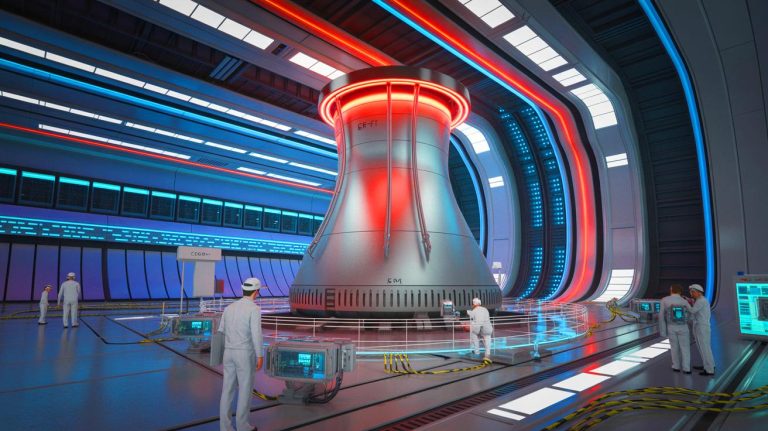| IN A NUTSHELL |
|
China has recently unveiled the CFR-1000, a next-generation fast neutron reactor that could revolutionize the nuclear energy landscape. This ambitious project promises to generate up to 1.2 gigawatts of power, enough to supply electricity to around one million homes. As countries worldwide grapple with rising energy demands and environmental concerns, China’s technological leap forward presents both opportunities and challenges. The CFR-1000 is slated to become operational by 2034, pending regulatory approval. The implications of this advancement could reshape global energy strategies and influence the future of nuclear power development.
The Potential of Fast Neutron Reactors
The introduction of the CFR-1000 signifies a shift towards fourth-generation nuclear reactors, which utilize fast neutrons instead of the slow neutrons common in current thermal reactors. This design does away with the need for materials like water to decelerate neutrons, instead relying on high-speed neutrons to maintain nuclear fission. The result is a significant improvement in both fuel efficiency and energy output.
Fast neutron reactors offer the promise of closed-loop fuel cycles, with the capability to “breed” new fuel such as plutonium-239 from non-fissile substances like uranium-238. This process can greatly reduce nuclear waste and decrease the demand for fresh uranium mining. By reusing nuclear waste, the technology aligns with global initiatives to reduce environmental impact and foster sustainable energy solutions. The CFR-1000 could play a pivotal role in advancing these efforts and setting new standards for nuclear energy.
Innovative Cooling Techniques
A noteworthy feature of the CFR-1000 is its use of liquid sodium as a coolant, a departure from the more traditional water-cooled systems. Liquid sodium efficiently transfers heat and enables the reactor to function at higher temperatures, enhancing both efficiency and energy output potential.
While the sodium coolant reduces some of the risks associated with water-based systems, such as the possibility of steam explosions, it also introduces new challenges. Handling liquid sodium requires meticulous care to prevent chemical reactions. As the CFR-1000 progresses towards operational status, these technical aspects will be under rigorous scrutiny by both Chinese regulators and international observers. The success of this cooling system could influence future reactor designs worldwide.
Challenges and Regulatory Hurdles
Despite its promising innovations, the CFR-1000 faces significant regulatory challenges before it can be brought online. Ensuring nuclear safety is of utmost importance, particularly with fast neutron reactors, which exhibit different operational characteristics than conventional systems. The approval process is intricate, involving multiple stakeholders and exhaustive safety evaluations.
The international community will be paying close attention, not only due to safety concerns but also because of the geopolitical implications these technological advancements entail. China’s leading role in nuclear technology could alter global energy dynamics and sway international energy policies. The journey of the CFR-1000 towards approval and operation will likely spark extensive international discourse in the years to come.
Global Implications and Future Prospects
As China advances with the CFR-1000, other countries may find it necessary to reassess their nuclear strategies. The potential for fast neutron reactors to offer more efficient and sustainable energy solutions could significantly influence global energy policies. Nations seeking energy independence and aiming to reduce carbon emissions may look to similar technologies to enhance their energy portfolios.
The CFR-1000 could serve as a standard for future nuclear developments, prompting further research and investment in this area. As the world strives to balance energy needs with environmental responsibilities, the role of nuclear power, particularly advanced reactors like the CFR-1000, could become more prominent. However, how other countries will respond to China’s technological advancements remains to be seen.
The development of the CFR-1000 represents a major step forward in nuclear energy innovation. As it nears operational status, the reactor holds the potential to significantly impact global energy strategies and environmental sustainability. The key question remains: How will other nations adapt to this shift in nuclear technology, and what role will fast neutron reactors play in the future of energy production?
Did you like it? 4.6/5 (20)







Wow, China is really stepping up its energy game! 🌟
What are the potential environmental impacts of using liquid sodium as a coolant?
It’s about time someone tries something new with nuclear power! 👍
How does the CFR-1000 compare with other fast neutron reactors currently being developed?
Hope this doesn’t spark another cold war over energy dominance. 😬
This sounds promising, but 2034 is a long way off. Why such a long timeline?
Does anyone else find the use of liquid sodium slightly terrifying? 🔥
I wonder how this will affect uranium mining industries worldwide.
China might just be leading the way to a more sustainable future. 🌍